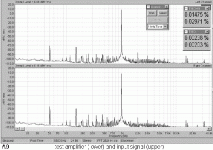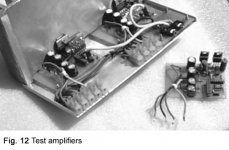Graham Maynard said:Hi Lumanauw,
I left diyAudio once before, and it was not because of necessary discussion, but due to 'minority attitude' and the intemperate manners that detract from the friendliness that might otherwise arise.
I have seen a need to pass on information that might not have otherwise been discussed, and I have gained by learning there is a different understanding that is not incorrect, but which does not lead to the same results and conclusions by as easy a route.
That need to discuss and present my views (with a quite understandable suggestion of stubborness in so doing) has been on a 'while I am able' basis.
I still feel that there is a need for further discussion, but it is now more important that I get away from the unresolved and personally directed friction, for my long term ill health is catching up with me, and the effort necessary to battle against such unnecessary adversity has been quite exhausted.
I will follow Carlos' friendly and humourous threads, but that is all.
Au revoir ............. Graham.
Graham,
Sorry to see you go, but please be ensured that any adversery from my side was never directed to the person Graham Maynard. I may have given that impression once or twice, - but I'm not perfect either!
Hope you get well soon.
Jan Didden
MBK said:....In your wording, you would call only undamped resonant behavior "oscillation". Do I interpret this correctly?
Oh, for sure !!!
I allways implicitely undertood oscillator as something that goes on indefinitelly.
Damped oscillations of course may be treated completelly within a linear context. Damped oscillation corresponds to conjugate pole pairs located more or less close to the imaginary axis, the father away the faster they die out.
It is fortunate a civilized exchange can succeed in agreement on the basis of reasoning and good will.
Rodolfo
mauropenasa said:..Ps: if at least some of the mathematical experts are able to think ( and build ) to a "decent" amp with technology of this century...
goodbye
Mauro
Sorry you want to leave Mauro.
With respect to the latter, how would you like this? Stay tuned, I will be releasing more details as soon as circumstances allow.
Note upper trace is input signal, lower is output (attenuated to match level). Card's lower channel input performance is slightly better.
Rodolfo
Attachments
janneman said:
Graham,
Sorry to see you go, but please be ensured that any adversery from my side was never directed to the person Graham Maynard. I may have given that impression once or twice, - but I'm not perfect either!
Hope you get well soon.
Jan Didden
Originally posted by darkfenriz
Graham, recover quickly!
Will miss discussions with You, which were even more interesting when people (including me ) had different opinions...
cheers
Fully endorsed. Sign me up in the good wishes.
Rodolfo
Hi Graham
Hugh Dean has said that the Aksas are not best in this particular area, saying:
If you want to drive ESLs there are only a couple of choices.
One is tube amps, which, with low feedback circuits, are assuredly good with these loads. The second is zero feedback mosfet SE designs, a la Nelson Pass, which drive them beautifully.
How would you design go driving ESLs?
Hugh Dean has said that the Aksas are not best in this particular area, saying:
If you want to drive ESLs there are only a couple of choices.
One is tube amps, which, with low feedback circuits, are assuredly good with these loads. The second is zero feedback mosfet SE designs, a la Nelson Pass, which drive them beautifully.
How would you design go driving ESLs?
It is fortunate a civilized exchange can succeed in agreement on the basis of reasoning and good will.
Rodolfo,
de nada
(I appreciate as well)
Sensitivity analysis
As promised (far too many weeks ago), here is a rough sensitivity analysis for voltage vs. current mode drive, trying to go a little deeper than the Hawksford paper commented earlier.
For the sake of transparency, I attached both the text and an Exel worksheet with the corresponding calculations. I encourage those interested (and patient enough) to check for eventual blunders.
In a nutshell, and for the particualr driver for which actual numbers are given, there does not look to be a definite advantage for current mode drive, but the situation may be different for other units. (By the way, this may be an interesting benchmark to compare with actual distortion measurements).
Rodolfo
Here is the PDF
As promised (far too many weeks ago), here is a rough sensitivity analysis for voltage vs. current mode drive, trying to go a little deeper than the Hawksford paper commented earlier.
For the sake of transparency, I attached both the text and an Exel worksheet with the corresponding calculations. I encourage those interested (and patient enough) to check for eventual blunders.
In a nutshell, and for the particualr driver for which actual numbers are given, there does not look to be a definite advantage for current mode drive, but the situation may be different for other units. (By the way, this may be an interesting benchmark to compare with actual distortion measurements).
Rodolfo
Here is the PDF
Attachments
lumanauw said:Rodolfo,
Your PDF is very heavy mathJust a question. Is there anything you find in your study, why if we make amp with quite big output impedance (1-6ohm or even more), the sound is said like tube (tubey)?
Lumanauw,
you have to take into account the speaker used. With 1 - 6 Ohms of amp's output impedance, you dramatically change speaker's behavior (Q, transient response, and even amplitude response). The conventional dynamic speaker should always be driven by voltage source, i.e. amp with the lowest output impedance.
I am sorry, but current drive of a conventional dynamic speaker is nothing but nonsense. Speaker's, box and environmental acoustical/mechanical impedances must be considered when designing the loudspeaker box. Current drive changes everything completely. There is nothing easier than to put a resistor in series with amp's output terminals, listen to the result (and measure it), and tell me if you like it :-(.
Probably there might be someone who prefers the amplitude response of the speaker resembling its impedance vs. frequency curve. In this case it is his choice, no one can forbid individual preferences.
Probably there might be someone who prefers the amplitude response of the speaker resembling its impedance vs. frequency curve. In this case it is his choice, no one can forbid individual preferences.
lumanauw said:....Is there anything you find in your study, why if we make amp with quite big output impedance (1-6ohm or even more), the sound is said like tube (tubey)?
The coil velocity frequency response for current mode drive, follows the mechanical impedance shape. Thus if the speaker resonance region is within the working frequency range, there will be a more or less pronounced peaking. This is the same as recongnizing there is very limited damping.
Rodolfo
MBK said:Rodolfo,
thanks for the derivation - this kind of results is so much more useful than some kind of "yes it is - no it isn't" exchanges in these forums... and also more convincing.
BTW I believe heuristics have their place , lest we just discuss textbook approaches ...
Thanks for the comment. Heuristics has a place as source of lines of inquiry, not a proof by itself. After a possible theory is sketched, it is the time of substantiating it with hard facts and reasoning.
Rodolfo
PMA said:.....
Probably there might be someone who prefers the amplitude response of the speaker resembling its impedance vs. frequency curve. In this case it is his choice, no one can forbid individual preferences.
I was thinking those last days about launching a thread with the subject more or less in the lines of "Audiophile vs. fidelity, where do you camp?".
A demonstrable perfect amplifier-speakers combination may not satisfy a lot of people who prefer (uncknowinlgy sometimes) to use these last links in the chain as an instrument of sorts to fit their tastes.
Rodolfo
ingrast said:
A demonstrable perfect amplifier-speakers combination may not satisfy a lot of people who prefer (uncknowinlgy sometimes) to use these last links in the chain as an instrument of sorts to fit their tastes.
Rodolfo
And that is the case. If you start to to satisfy individual, and mostly temporary preferences, you are about to start your way to the designer's hell
PMA said:
And that is the case. If you start to to satisfy individual, and mostly temporary preferences, you are about to start your way to the designer's hell. Different people = different preferences, and usually rapidly changing, depending of the "development" of the listener and his experience
. That's why I prefer correct technical approach and try to find parameters that are important for sound reproduction. But I cannot agree with solutions that are technically wrong. Maybe satisfying one listener, but dissatisfying many others. For example if you are a lover of classical music and big orchestra, no "musical" distortion can "improve" the sound you listen to.
That is true, but sometimes a designer gets it just right. I remember reading an interview with Stan Curtis, who designed the hugely successfull range of Rotel amps in the late 90-ies. He admitted that he knew "how to manipulate the design so people loved it". Reviewers were frustrated because the measurements were not particular hot, but man they loved to listen to them. Sold 100's of thousands amps!
Jan Didden
- Status
- This old topic is closed. If you want to reopen this topic, contact a moderator using the "Report Post" button.
- Home
- Amplifiers
- Solid State
- The many faces of distortion

